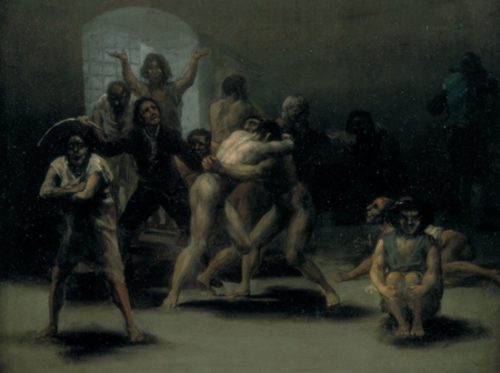
Yard with Lunatics (cropped) by Francisco Goya
There is such a cliche about artists and madness. Perhaps there’s a bit of truth to it: people who struggle sometimes see the world creatively; creative people may struggle to fit into the boxes that define the norm. It’s tempting to simplify this, but it’s a mistake. Many people living with mental health issues aren’t able to create at all, despite desperately wanting to. Illness takes over. And yet, there are some amazing people who persevere and create magnificent works of art despite their challenges.
In fact, a surprising number of works from famous artists were created while those people recovered in asylums, at mental health retreats, or other inpatient care. Some were created afterwards, but depicted what the artists saw in those places. If you’ve ever seen One Flew Over the Cuckoo’s Nest then you know that art can depict those places in the most horrifying of ways. We may even want to look away. But looking at those challenging pieces can help us better understand some of the darkest times an artist has gone through.
Here are five works that specifically depict the asylum / hospital experience.
1. Corridor in the Asylum by Vincent Van Gogh
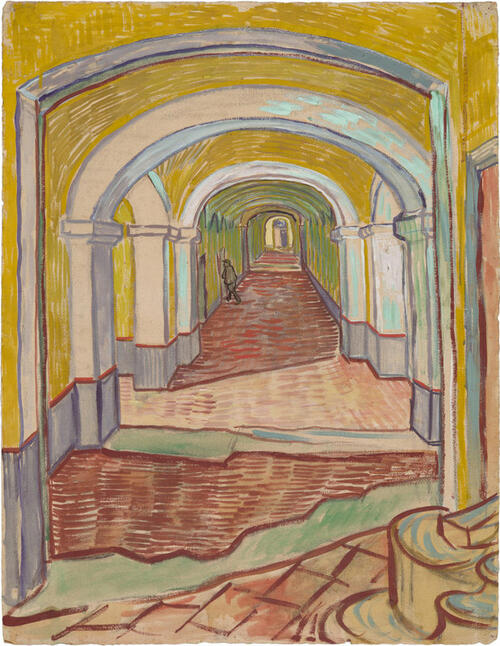
Corridor in the Asylum by Vincent Van Gogh, The Met Museum
Vincent Van Gogh created magical works of art depicting nature. His flowers, wheat fields, trees, and seascapes continue to inspire the imagination of viewers today. The painted-in-detail film "Loving Vincent" is only one of many recent examples of how artists continue to draw from his work.
The artist painted what he saw. Not all of his life was spent soaking in the beauty of landscapes bathed in natural light. He spent one terrible year of his life in the Saint-Paul de Mausole asylum. What he saw was the empty, seemingly-endless hallway represented in Corridor in the Asylum.
His letters at this time indicate that there were more than two dozen empty rooms in this corridor. He was relieved that the patients who were there didn’t harass him about his work or seem to judge his finished paintings. Still, he wasn’t exactly thrilled to have this as his inspiration. He only did a couple of other paintings of the asylum’s interior and he strictly avoided depicting what his own room there looked like, despite sharing paintings of his personal bedroom from when he was not at the asylum.
Life at the asylum was anything but pleasant. He wrote of his experience, “one continually hears shouts and terrible howls as of animals in a menagerie.” The terrifying sounds must have echoed horribly in that corridor. One patient he shared space with had auditory hallucinations and Van Gogh wrote that he seemed to be responding aloud to sounds in the corridor that no one else could hear.
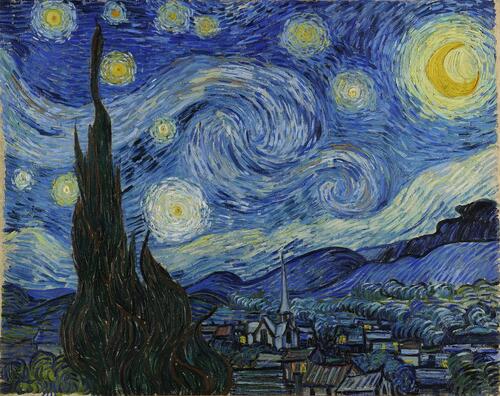
Starry Night by Vincent Van Gogh, MoMA
Despite the need to paint some of his experience, Van Gogh did all that he could to paint the more pleasing landscapes he remembered from his life before the institution. Whenever possible, he would sit in the asylum’s gardens, painting what he saw there instead. He arguably even created some of his best work there, including Starry Night. He was forced to imagine better times alone since nobody ever came to visit him in the asylum.
2. The Madhouse by Francisco Goya
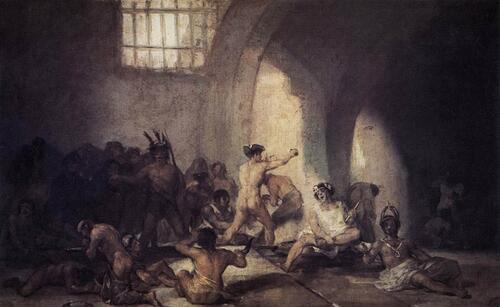
The Madhouse by Francisco Goya at the Royal Academy of Fine Arts of San Fernando
Not one to sugarcoat things with a pretty name, Goya aptly called this painting The Madhouse. A similar painting from the asylum is called Yard with Lunatics. It leaves little to the imagination in terms of what his experience there was like.
Goya actually painted two versions of The Madhouse, the first in a vertical format and the second as the horizontal image most people are familiar with. In both we see the chaos of the madhouse experience. Naked men grapple with each other or with invisible deities. Chiefs and kings represent authority figures that easily suggest the horrifying power dynamics in 18th century asylums.
Comparing the earlier and later images, the difference that stands out most is that the latter is even more chaotic than the first. It’s as though the setting was eating away at Goya’s mind and he had to change the painting to reflect the madness in an even more thorough way.
Although he may have been losing his own mind there, his work is representative of an important turn in art history as it relates to mental health. He was on the cutting edge of what would emerge in the nineteenth century as a fascination with the subject of madness in art. There was a shift in society; madness had been something people gawked at for entertainment and was now becoming something to hide away in asylums. The art of the time reflects a new interest in what it means to be a part of this shifting culture when you as an artist are coping with mental illness.
3. Creative Therapy by Jacob Lawrence
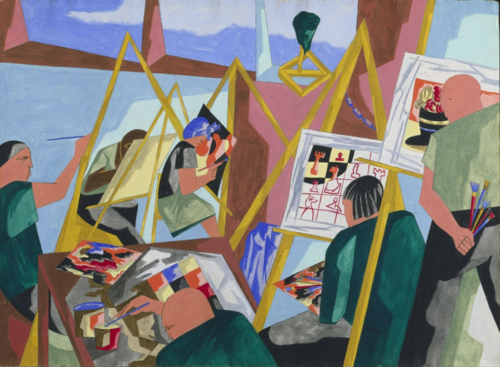
Creative Therapy by Jacob Lawrence, Cleveland Museum of Art
The asylum experience doesn’t have to be horrible. Some people check themselves into an institution to get treatment and get lucky - they’re there at the right time in society, with the right doctors, and they get the care that they need. Art therapy has been a part of many asylum stays, and certain artists have thrived thanks to that creative outlet.
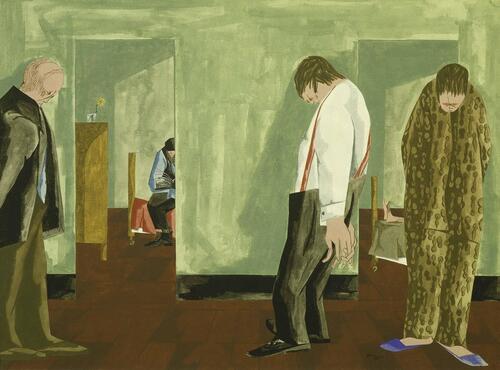
Depression by Jacob Lawrence at the Whitney Museum of American Art
Jacob Lawrence painted his Hospital series depicting the experiences he had while dealing with depression in an institution. Most of the work from this time is dark, as one would expect from scenes of an asylum. One of the most well-known works is Depression, which describes not only his own experiences of that mental illness but the depressed experience of being in the institution. Likewise Sedation, featuring psychiatric pills, emphasizes that there’s a clear question about whether the illness or the “cure” is the problem.
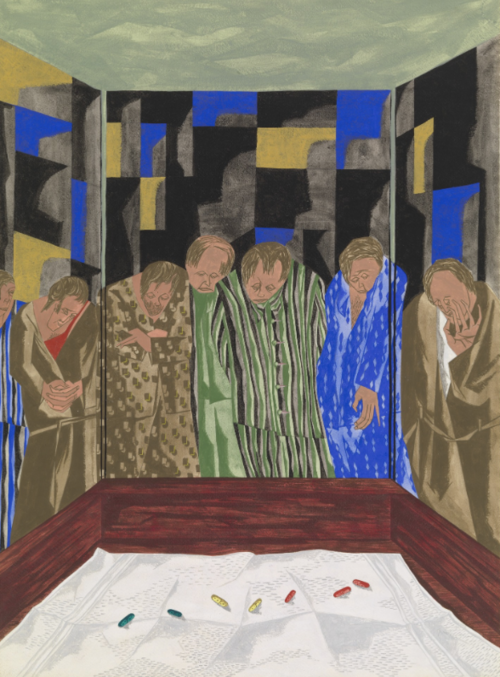
Sedation by Jacob Lawrence, MoMA
However, Creative Therapy offers a more positive take on what can happen in the asylum, particularly in terms of healthy treatment. It depicts the artist participating in an art therapy group there, led by a psychiatrist, in which he explored different aspects of his art and used color and perspective in new ways. Art does have therapeutic value, and when artists are allowed to work with it in therapy it can make all the difference in whether their creative impulse shrivels or thrives.
In a fun twist that he may have appreciated, Lawrence’s paintings have served as important discussion starters among older adults in contemporary art therapy groups.
4.Henry Ford Hospital by Frida Kahlo
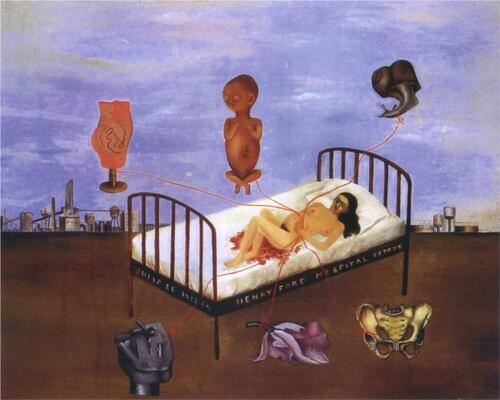
Henry Ford Hospital by Frida Kahlo at the Dolores Olmedo Museum
This one isn’t quite from the asylum but it might as well have been. Frida Kahlo had spent her pregnancy on bedrest only to suffer a miscarriage that required an abortion to complete the process. That horrifying experience happened at Henry Ford Hospital.
She went into a deep depression, which she tried to process through her art. Each stage of the miscarriage and hospital experience is depicted in this painting, which began as a sketch while she was still in the hospital. The viewer’s eyes don’t know where to look and may want to turn away altogether. It’s lonely, scary, desolate, and desperate.
And although the experience didn’t take place in a traditional asylum, one can imagine that in this hospital setting she experienced that similar combination of focus on her the weaknesses of her mental health combined with inattentive care to the horrible experience of loss and depression she underwent during her two week stay there.
Although this is perhaps the most famous work depicting Kahlo’s struggles with infertility, it’s not the only one. In fact, some argue that it’s a critical theme throughout her work. This was only one of three medically-necessary abortions she had, and she suffered other miscarriages as well. Undoubtedly, this affected her mental health. The hospital bed is symbolic of the inevitable tie between physical and mental health, though historically society has often chosen to ignore this important link.
5. The State Hospital by Edward Kienholz
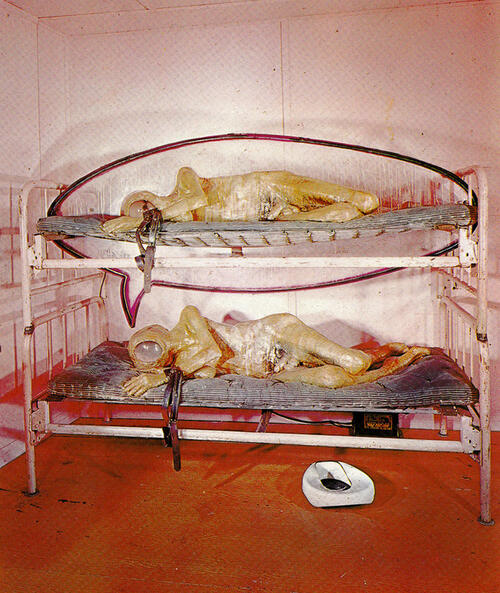
The State Hospital by Edward Kienholz
Edward Kienholz wasn’t a patient at an asylum. He was part of the staff. It didn’t make him any less affected by the horrors that can happen when things don’t go well in an institutional setting. The State Hospital reflects those horrors in all of their gory detail. He created this piece in the 1960s, nearly two decades after his two year internship in the hospital, but the experience was seared into his memory.
He described the asylum in terms that include the words: prison, brutality, and dirty. He even said that One Flew Over The Cuckoo’s Nest was a model asylum compared to what he saw where he worked. His installation includes a model who was in actuality about to die from cancer, so he expressed that living in the asylum was essentially like being dead. The cavernous spaces in the heads in this piece suggest minds atrophying.
For several years prior to this piece, Kienholz’s installations were designed to shed light on individual horrors including those afflicting people troubled by mental illness. This piece added a new element though; holding society accountable for the abuses these marginalized people endured.
This post is part of our series on Mental Health Art History. We’ve previously shared two posts on artists with depression, plus posts on bipolar artists, artists with schizophrenia, and the unique condition of Misere.
Sources
- Bailey, Martin. Starry Night: Van Gogh at the Asylum. White Lion Publishing. 2018.
- Groom, Gloria Lynn. “Van Gogh’s Bedrooms.” Yale University Press. 2016.
- Hills, Patricia. “Painting Harlem Modern: The Art of Jacob Lawrence.” University of California Press. 2019.
- Kennedy, Maev. “Van Gogh’s ‘Terrifying Environment’ of French Asylum Revealed.” The Guardian. Aug 25, 2018. Retrieved 5/31/19 from https://www.theguardian.com/artanddesign/2018/aug/25/vincent-van-gogh-d…
- Kettenmann, Andrea. “Frida Kahlo, 1907-1954: Pain and Passion.” Taschen. 2000.
- Loving Vincent, http://lovingvincent.com
- Munoz, Gabriela. “Understanding Frida Kahlo’s Fertility Problems.” Science Illustrated. May 3, 2012. Retrieved 5/31/ 19 from https://scienceillustrated.com.au/blog/science/news/understanding-frida…
- Partridge, Erin. “Art Therapy with Older Adults: Connected and Empowered.” Jessica Kingsley Publishers. 2019.
- Pincus, Robert L. “On a Scale that Competes with the World: The Art of Edward and Nancy Reddin Kienholz.” University of California Press. 1990.
- Snell, Robert. “Uncertainties, Mysteries, Doubts: Romanticism and the analytic attitude.” Routledge. 2012.
- Stoichita, Victor I. & Coderch, Anna M. “Goya: The Lats Carnival.” Reaktion Books. 1999.
Comments (7)
Very nice blog.

Reagan ruined America by shutting down the mental hospitals. Have you seen the state of California, who would ever want to live there?

Your post has been removed by moderators as hate speech of any kind will not be tolerated.

All these blogs about mental health make me think I should see a therapist.










You are right to think about how to avoid and cure pain